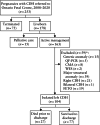Predicting neonatal mortality prior to discharge from hospital in prenatally diagnosed left congenital diaphragmatic hernia
- PMID: 39445505
- PMCID: PMC11609950
- DOI: 10.1002/uog.29121
Predicting neonatal mortality prior to discharge from hospital in prenatally diagnosed left congenital diaphragmatic hernia
Abstract
Objectives: To evaluate the association of standardized prenatal imaging parameters and immediate neonatal variables with mortality prior to discharge in infants with isolated left congenital diaphragmatic hernia (LCDH), and to compare the performance of ultrasound- and magnetic resonance imaging (MRI)-based severity grading for the prediction of neonatal mortality.
Methods: This was a retrospective study of infants with prenatally diagnosed isolated LCDH referred to a single tertiary center between 2008 and 2020. Fetuses with right or bilateral congenital diaphragmatic hernia, additional major structural anomaly or known genetic condition, as well as cases that underwent fetal intervention or declined postnatal intervention, were excluded. Ultrasound and MRI images were reviewed retrospectively. Univariable and multivariable analyses were performed, incorporating prenatal and immediate neonatal factors to analyze the association with neonatal mortality prior to discharge, and a prediction calculator was generated. The performance of ultrasound and that of MRI for the prediction of neonatal mortality were compared.
Results: Of 253 pregnancies with fetal CDH, 104 met the inclusion criteria, of whom 77 (74%) neonates survived to discharge. Seventy-five fetuses underwent both prenatal ultrasound and MRI. On multivariable analysis, observed/expected (o/e) lung-to-head ratio and o/e total fetal lung volume were associated independently with neonatal death (adjusted odds ratio, 0.89 (95% CI, 0.83-0.95) and 0.90 (95% CI, 0.84-0.97), respectively), whereas liver position was not. There was no significant difference in predictive performance between using ultrasound and MRI together (area under the receiver-operating-characteristics curve (AUC), 0.85 (95% CI, 0.76-0.93)) compared with using ultrasound alone (AUC, 0.81 (95% CI, 0.72-0.90); P = 0.19). The addition of neonatal parameters (gestational age at birth and small-for-gestational age) did not improve model performance (AUC, 0.87 (95% CI, 0.80-0.95)) compared with the combined ultrasound and MRI model (P = 0.22). There was poor agreement between severity assessment on ultrasound and MRI (Cohen's κ, 0.19). Most discrepancies were seen among cases deemed to be non-severe on ultrasound and severe on MRI, and outcomes were more consistent with MRI-based prognostication.
Conclusions: In fetuses with prenatally diagnosed isolated LCDH, mortality prediction using standardized ultrasound and MRI measurements performed reasonably well. In cases classified as non-severe on ultrasound, MRI is recommended, as it may provide more accurate prognostication and assist in the determination of candidacy for fetal intervention. © 2024 The Author(s). Ultrasound in Obstetrics & Gynecology published by John Wiley & Sons Ltd on behalf of International Society of Ultrasound in Obstetrics and Gynecology.
Keywords: CDH; MRI; congenital diaphragmatic hernia; magnetic resonance imaging; neonatal mortality; ultrasound.
© 2024 The Author(s). Ultrasound in Obstetrics & Gynecology published by John Wiley & Sons Ltd on behalf of International Society of Ultrasound in Obstetrics and Gynecology.
Figures


 , ultrasound‐only model (includes gestational age (GA) at diagnosis, observed/expected (o/e) lung‐to‐head ratio, intrathoracic posterior/retrocardiac stomach position, female sex and polyhydramnios);
, ultrasound‐only model (includes gestational age (GA) at diagnosis, observed/expected (o/e) lung‐to‐head ratio, intrathoracic posterior/retrocardiac stomach position, female sex and polyhydramnios);  , MRI‐only model (includes GA at diagnosis, o/e total fetal lung volume, intrathoracic liver location and female sex);
, MRI‐only model (includes GA at diagnosis, o/e total fetal lung volume, intrathoracic liver location and female sex);  , ultrasound + MRI model (includes all variables from ultrasound‐only model and MRI‐only model);
, ultrasound + MRI model (includes all variables from ultrasound‐only model and MRI‐only model);  , ultrasound + MRI + immediate neonatal factors model (includes all variables from ultrasound + MRI model plus small‐for‐gestational age and GA at delivery < 37 weeks).
, ultrasound + MRI + immediate neonatal factors model (includes all variables from ultrasound + MRI model plus small‐for‐gestational age and GA at delivery < 37 weeks).
References
-
- Kluth D, Tenbrinck R, von Ekesparre M, et al. The natural history of congenital diaphragmatic hernia and pulmonary hypoplasia in the embryo. J Pediatr Surg. 1993;28:456‐463. - PubMed
-
- Bouchghoul H, Senat M‐V, Storme L, et al. Congenital diaphragmatic hernia: does gestational age at diagnosis matter when evaluating morbidity and mortality? Am J Obstet Gynecol. 2015;213:535.e1–7. - PubMed
-
- Dommergues M, Louis‐Sylvestre C, Mandelbrot L, et al. Congenital diaphragmatic hernia: can prenatal ultrasonography predict outcome? Am J Obstet Gynecol. 1996;174:1377‐1381. - PubMed
-
- Russo FM, Eastwood MP, Keijzer R, et al. Lung size and liver herniation predict need for extracorporeal membrane oxygenation but not pulmonary hypertension in isolated congenital diaphragmatic hernia: systematic review and meta‐analysis. Ultrasound Obstet Gynecol. 2017;49:704‐713. - PubMed
-
- Knox E, Lissauer D, Khan K, Kilby M. Prenatal detection of pulmonary hypoplasia in fetuses with congenital diaphragmatic hernia: a systematic review and meta‐analysis of diagnostic studies. J Matern Fetal Neonatal Med. 2010;23:579‐588. - PubMed
MeSH terms
Grants and funding
LinkOut - more resources
Full Text Sources
Medical
Miscellaneous

